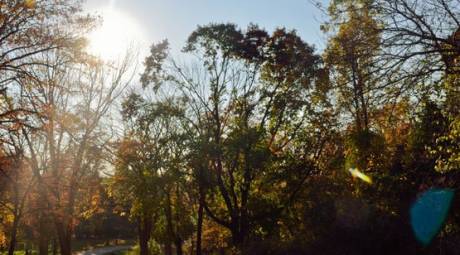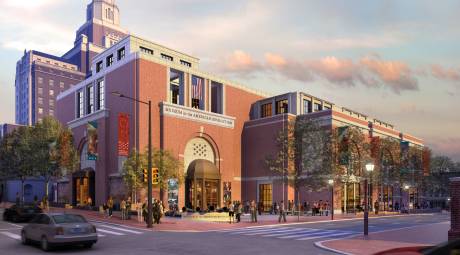The Places
Revolutionary War Sites in Montgomery County
Learn more about the historic sites in Valley Forge and Montgomery County: the historic homes and locations that helped shape our nation during the Revolutionary War. Each site has its own history and its own unique story for you to explore.

VALLEY FORGE NATIONAL HISTORICAL PARK
No name is more synonymous with the American Revolution than Valley Forge. George Washington led his Continental Army into Valley Forge in December, 1777. They would spend the next six months molding groups of divided soldiers into one united Continental Army. The Valley Forge National Historical Park now helps tell the story of the 12,000 soldiers who made Valley Forge their temporary home.

FORT WASHINGTON STATE PARK
Prior to its arrival at Valley Forge, the Continental Army spent a month encamped in an area known as Whitemarsh. Much of the land that was once occupied by the soldiers has been preserved in Fort Washington State Park. There is no trace of the original fort remaining, but you can walk the 3.5 miles of trails on the same land where the patriots made their temporary home.
GRAEME PARK
Graeme Park was originally built in 1722 as the home of Pennsylvania governor William Keith. During the Revolution, it was owned by British loyalist Henry Hugh Fergussen and his wife Elizabeth Graeme. The home was seized by the colonial government because of Fergussen's British ties. Today the manor house and surrounding gardens make up Graeme Park and are open to the public year-round.

HARRITON HOUSE
Originally known as Bryn Mawr, the house was renamed Harriton by second owner Richard Harrison. During the Revolution, it was the home of Charles Thomson, Secretary of the Continental Congress. A minor skirmish occurred in the surrounding property in December, 1777 when General James Potter's men encountered a British raiding party led by General Charles Cornwallis. Today, Harriton House has been restored to the reflect Charles Thomson's years in the home and is open for tours.

HOPE LODGE
Located adjacent to Fort Washington State Park, Hope Lodge also played an important role during the Whitemarsh Encampment, serving as the headquarters for Surgeon General Dr. John Cochran. Hope Lodge is open for tours on select dates throughout the year, including the annual Whitemarsh Encampment reenactment each November.

MUSEUM OF THE AMERICAN REVOLUTION
The Museum of the American Revolution in nearby Philadelphia brings the story of the American fight for independence to life with a mix of modern, innovative exhibits and historic artifacts. The highlight of the collection is Washington's Headquarters Tent, first used at Valley Forge in 1778.
PAOLI BATTLEFIELD
In September, 1777, Paoli Tavern was the site of a bloody battle between the British and American sides. The British struck during the middle of the night, tearing through Anthony Wayne's men with bayonets and swords. The more than 50 Americans who died here are memorialized in what is now a public park.
PENNYPACKER MILLS
In late September, 1777, the Continental Army encamped in rural Montgomery County, with at least several division taking up residence at a local mill owned by Samuel Pennypacker. Following the Battle of Germantown, the Army once again returned to the site, with General Washington using Pennypacker's home as his temporary headquarters. The room where Washington slept remains a highlight of house tours to this day.
PETER WENTZ FARMSTEAD
One of two historic homes in Montgomery County that claim George Washington as a temporary resident, Peter Wentz Farmstead was site of the Continental Army's encampment immediately before and after the Battle of Germantown. The site continued to operate as a private farm until it was purchased by the county in 1969 and turned into a historic site that tells the history of early American farmlife.
POTTSGROVE MANOR
Besides food and clothing, the most important resource the men of the Continental Army was ammunition. The Potts family owned several iron forges in the colonies, including Mount Joy Forge, also known as Valley Forge, and contributed greatly to the American cause. The Potts' estate, Pottsgrove Manor, is open for tours and reflects the lifestyle of the family in the 18th Century.

Indenhofen House
Skippack’s Indenhofen House, built circa 1713 , is one of the oldest farmsteads in PA. George Washington and his Revolutionary Army camped here and along the Skippack Creek just before the battle of Germantown.

SIDE TRIPS
The sites listed in our Patriot Trails are just some of the many historic gems in Montgomery County. It would be impossible to see all of the historic homes, museums and sites in one trip, but it is possible to squeeze in a few extra stops along way. We have curated a list of historic sites that would be of particular interest to those interested in early American and military history.
Revolutionary History in Montgomery County Explore Historic Trails
One Day Tour
George Washington spent six months in Valley Forge, but you only have one day to explore the rich history he left behind.
Montco History Pass
The legacy of George Washington and the Revolutionary War runs deep in Valley Forge and Montgomery County, PA. Explore historical sites and win prizes…


